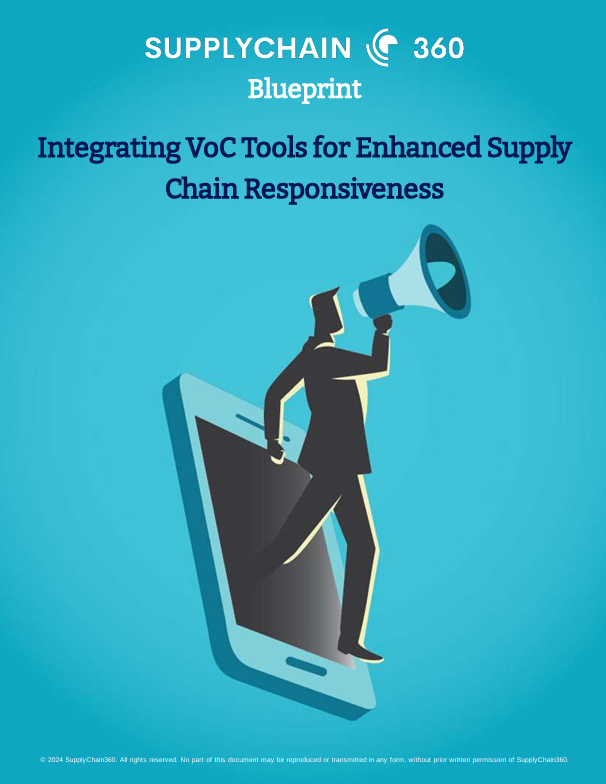
supply chain strategy
Blueprints
Supplychain360 blueprints offer an extensive collection of toolkits enabling swift access to best practice to enhance operations or to enable robust decision making.
This blueprint is designed to seamlessly integrate Voice of the Customer (VoC) tools into your supply chain operations. It tackles the significant challenge of aligning customer feedback with supply chain processes to enhance responsiveness and service quality.
Understanding and implementing VoC tools effectively can transform your operational efficiency and customer satisfaction levels. By following this blueprint, you will gain actionable insights and step-by-step guidance to navigate the complexities of customer data integration, ensuring that every decision enhances your competitive edge and aligns with customer expectations.
Leverage this comprehensive guide to foster a customer-centric approach within your supply chain, leading to sustained improvements and strategic success.
Detailed Implementation Steps: Advanced Integration of VoC Tools into SCM Processes
Step 1: Assessing Current VoC and SCM Integration
Evaluate Existing Processes: Conduct a thorough analysis of how current SCM operations capture and utilize customer feedback. Use process mapping to visualize existing workflows and identify inefficiencies or gaps in customer data utilization.
Stakeholder Interviews: Organize structured interviews with stakeholders across key departments (SCM, customer service, marketing, IT) to gather qualitative insights into current VoC practices and perceptions.
Technology Audit: Perform a comprehensive review of existing SCM and customer feedback systems. Assess their functionality, data handling, integration capabilities, and scalability to handle new VoC tools.
Model/Framework Application: Utilize the GAP model of service quality to systematically identify where customer expectations are not met. This model helps in pinpointing specific areas within the supply chain that require improvement to enhance customer satisfaction.
Step 2: Selecting Appropriate VoC Tools
Define Tool Requirements: Based on the identified gaps, detail the functionalities required in VoC tools, such as real-time data processing, advanced sentiment analysis, and integration with ERP systems.
Market Research: Conduct extensive research to create a comprehensive list of VoC tools that meet the predefined specifications. Include an evaluation of emerging technologies like AI-driven analytics platforms.
Tool Selection Criteria: Develop a detailed selection matrix that includes criteria such as cost-effectiveness, user-friendliness, technical support, vendor stability, and user reviews.
Pilot Testing: Implement a pilot program with shortlisted tools in selected areas of the supply chain. Monitor the effectiveness and gather user feedback to assess the impact on SCM efficiency and responsiveness.
Step 3: Training Teams and Setting Up Systems
Customized Training Programs: Design and execute tailored training programs for different teams, focusing on specific functionalities of the selected VoC tools and their relevance to each team’s role.
Integration Setup: Collaborate with IT to ensure the selected VoC tools are fully integrated into the existing SCM infrastructure with robust data security measures. Test system integrations thoroughly to prevent data silos.
Change Management: Apply the ADKAR change management model to manage the transition. This includes specific actions like creating awareness through informational sessions, fostering desire through demonstrations of benefits, enhancing knowledge via hands-on training, enabling ability by providing ongoing support, and reinforcing changes through regular feedback and adjustments.
Step 4: Streamlining Data Collection and Analysis
Enhanced Data Collection Mechanisms: Implement multi-channel data collection strategies that encompass both direct customer feedback and indirect cues via social listening tools and market analysis software.
Advanced Analytical Frameworks: Deploy state-of-the-art analytical tools that employ machine learning to sift through large datasets to find actionable insights, predict customer behaviors, and optimize supply chain decisions.
Establishing a Continuous Feedback Loop: Set up regular review cycles for teams to assess how customer feedback is captured and utilized. Ensure there are clear protocols for rapidly implementing insights into SCM operations to keep the supply chain agile.
Step 5: Applying Insights to Enhance SCM Efficiency
Strategic Insight Application: Develop clear guidelines on how to apply customer insights to strategic SCM areas such as inventory management, demand forecasting, and delivery optimization.
Performance Monitoring System: Integrate advanced monitoring tools that track the real-time impact of changes made based on VoC insights. Use dashboards to display key performance indicators and generate alerts for anomalies.
Feedback Integration into Product Development: Ensure a seamless flow of VoC insights to product development teams, enabling data-driven product innovations. Facilitate cross-functional workshops to align product development with customer expectations gathered through VoC tools.
Best Practices for VoC Integration in Supply Chain Operations
When integrating Voice of the Customer (VoC) tools into supply chain operations, following best practices ensures that the implementation is not only successful but also sustainable. These guidelines provide a framework for supply chain leaders to maximize the value of customer feedback in their operational strategies.
Foster a Customer-Centric Culture: Cultivating a culture that prioritizes customer feedback is essential. Encourage all team members, from logistics to customer service, to consider how their actions impact customer satisfaction. Regular training and communication about the importance of customer feedback can reinforce this mindset.
Establish Clear Communication Channels: Effective communication channels between different departments (such as sales, customer service, and supply chain operations) are crucial. These channels ensure that customer insights are shared and understood across the organization, facilitating swift and coordinated responses to customer needs.
Implement Scalable Solutions: Choose VoC tools and processes that can grow with your organization. Scalability ensures that as your customer base expands and your supply chain becomes more complex, your ability to gather and react to customer feedback remains effective. Consider future needs when selecting technology and designing processes.
Regularly Review and Adapt Processes: The supply chain environment is dynamic, and customer preferences can change rapidly. Regular audits of the VoC integration process help identify areas for improvement and adapt strategies to better meet customer expectations. This could involve adjusting data collection methods or refining the analysis tools used.
Leverage Advanced Analytics: Utilize advanced analytics to derive actionable insights from customer data. Machine learning models can predict customer trends and behaviors, allowing supply chain managers to proactively adjust operations. This proactive approach can lead to improved customer satisfaction and operational efficiency.
Integrate Cross-Functional Teams: VoC should not be siloed within one part of the organization. Integrating cross-functional teams in the VoC process ensures diverse perspectives are considered and customer insights are comprehensively applied to improve products and services.
Document and Share Learnings: Documenting the outcomes and learnings from VoC initiatives provides a reference for future projects and helps in training new team members. Sharing success stories and challenges across the organization can also inspire teams to more actively engage with VoC tools and processes.
By adhering to these best practices, supply chain leaders can enhance their operations significantly through effective integration of VoC tools, leading to increased customer satisfaction and improved operational agility.
Key Metrics and KPIs for Measuring VoC Integration Success
Effective integration of Voice of the Customer (VoC) tools into supply chain management requires clear metrics and KPIs to evaluate success. These indicators help supply chain leaders monitor the impact of VoC initiatives and guide strategic decisions.
Customer Satisfaction Score (CSS): Measure customer satisfaction at various touchpoints in the supply chain to gauge immediate responses to operational changes. Track this metric through surveys post-interaction or purchase.
Net Promoter Score (NPS): This metric assesses customer loyalty and the likelihood of recommending your company to others. It provides insight into the long-term impact of improvements made based on customer feedback.
Order Accuracy Rate: Track the accuracy of order fulfillment post-VoC integration. An increase in this rate indicates that customer feedback is effectively used to enhance the precision of order processing and delivery.
Return Rate: Monitor the rate at which products are returned as a direct indicator of how well products meet customer expectations, which should ideally decrease as VoC insights are applied to operational adjustments.
Response Time to Customer Feedback: Measure how quickly the supply chain reacts to customer feedback. A shorter response time is often correlated with increased customer satisfaction and operational agility.
Supply Chain Reaction Time: This KPI tracks the speed at which the supply chain adapts to changes in customer preferences and demands, a direct reflection of operational flexibility.
Tracking and Interpreting Metrics:
Set up Dashboards: Implement real-time dashboards that provide ongoing insights into these KPIs, allowing for prompt adjustments.
Regular Reviews: Conduct regular review sessions to analyze these metrics. Use statistical tools to understand trends, outliers, and causal relationships.
Cross-Functional Feedback: Share performance data across departments to ensure that improvements align with overall business objectives and customer expectations.
By diligently monitoring these KPIs, supply chain leaders can quantitatively assess how well VoC tools and processes are integrated into the supply chain, ensuring continuous improvement and customer-centric decision-making.
Challenges and Solutions in Implementing VoC in Supply Chains
Integrating Voice of the Customer (VoC) tools into supply chain operations can encounter several challenges. Here are some common obstacles along with practical solutions to help supply chain leaders effectively manage and overcome these issues.
Challenge: Data Overload
Solution: Implement advanced data management systems that can filter and prioritize information based on its relevance and impact. Use AI and machine learning to automate the analysis of large data sets, ensuring that only actionable insights are presented to decision-makers.
Challenge: Resistance to Change
Solution: Foster an organizational culture that values adaptability and continuous improvement. Implement change management practices, such as the ADKAR model, to help staff understand the benefits of VoC integration. Offer continuous training and support to ease the transition.
Challenge: Integration with Existing Systems
Solution: Evaluate the current IT infrastructure and invest in middleware solutions that can seamlessly connect new VoC tools with existing ERP or CRM systems. Work closely with IT specialists to ensure compatibility and minimize disruptions during the integration phase.
Challenge: Ensuring Consistent Customer Feedback
Solution: Develop a robust strategy for collecting customer feedback across multiple channels. Standardize feedback mechanisms to ensure consistency and reliability of the data collected. Encourage customers to provide feedback by making the process simple and engaging.
Challenge: Aligning VoC Insights with Business Goals
Solution: Establish clear objectives for what the business aims to achieve with VoC insights. Regularly review these goals and align them with overall business strategies. Ensure that all stakeholders are aware of these objectives and understand how their roles contribute to achieving them.
Challenge: Quantifying the Impact of VoC
Solution: Define specific metrics and KPIs to measure the impact of VoC initiatives on supply chain performance. Regularly track these metrics and adjust strategies based on their performance to ensure continuous improvement.
By anticipating these challenges and implementing these solutions, supply chain leaders can effectively integrate VoC tools into their operations, leading to improved customer satisfaction and more efficient supply chain management.
This blueprint offers a clear path to embedding Voice of the Customer insights into your supply chain, enhancing responsiveness and customer satisfaction. Adopt these strategies to stay competitive by aligning your operations closely with customer expectations and driving continuous improvement.
Unlock the full potential of your supply chain operations by subscribing to SupplyChain360. Gain exclusive access to expert blueprints, detailed resources, and continuous updates designed to elevate your supply chain management. Subscribe now and lead the way in innovation and efficiency.







